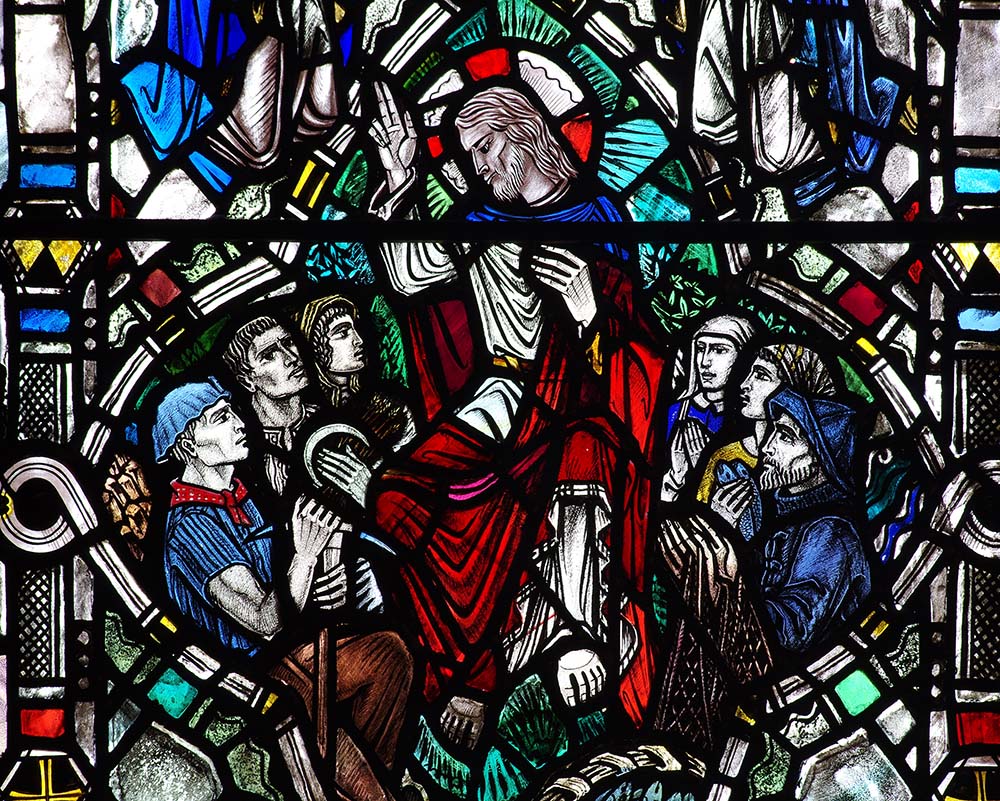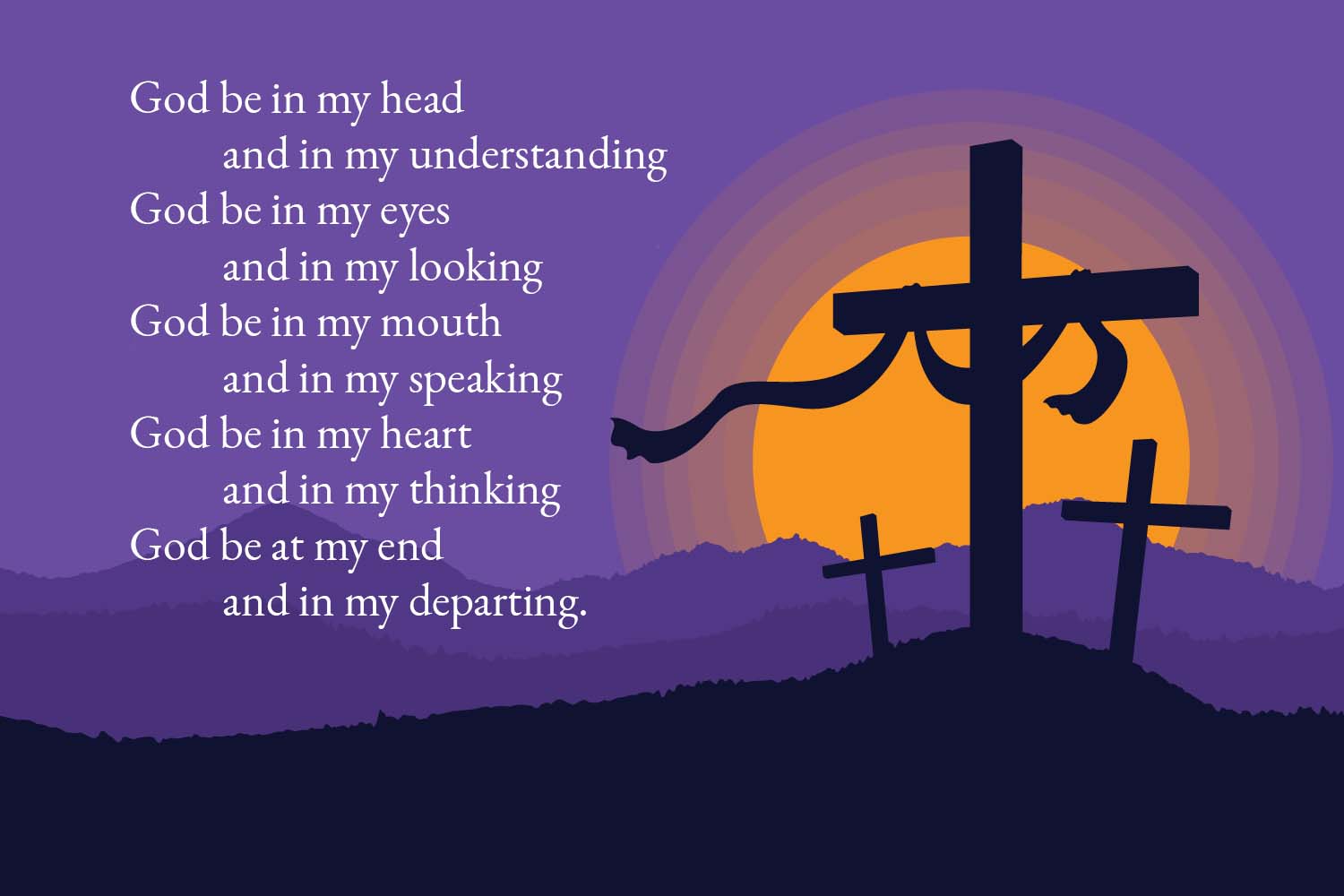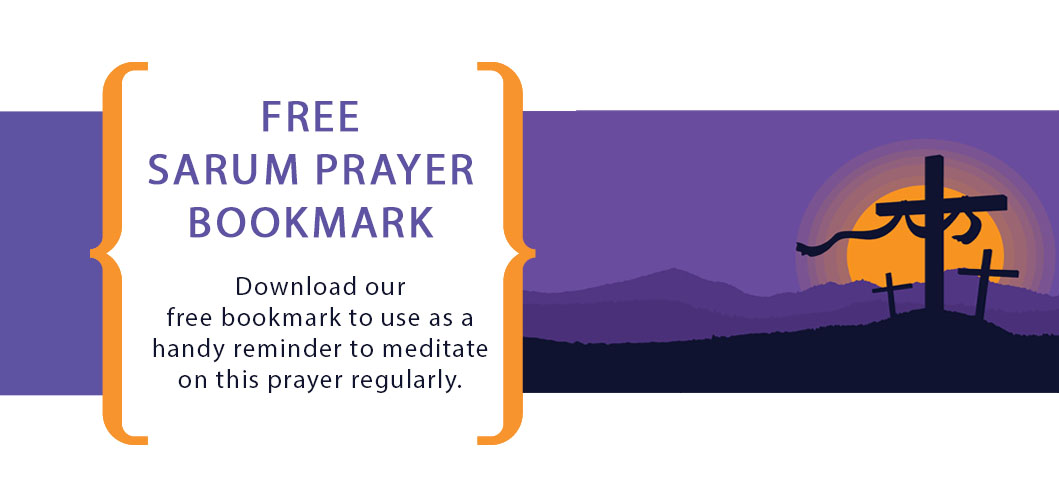One of my favorite prayers is a prayer dating back to the mid-1500s, and probably earlier, called the Sarum Prayer. The Sarum Prayer succinctly addresses our daily life and the end of our life, yet with such grace and a sense of confidence. It’s a prayer that will bring us closer to God, especially with consistent use.
What is the Sarum prayer?
The Sarum prayer is a short prayer that fosters a greater connection with God. Much like the Serenity Prayer, it offers a meditation that can help people get through the day.
It’s only five lines long:
God be in my head — and in my understanding
God be in my eyes — and in my looking
God be in my mouth — and in my speaking
God be in my heart — and in my thinking
God be at my end — and in my departing.
What does Sarum mean?
The name Sarum refers to a liturgical rite associated with an old borough near Salisbury, in south-central England, from whence this prayer hails. The Sarum prayer is also often referred to simply as the “God be in my head” prayer.
Who wrote the prayer “God be in my head”?
It’s unknown who wrote the original prayer. In the early 1900s, the prayer was turned into a hymn by the English composer Sir Henry Walford Davies.
Insights about the Sarum Prayer
I’m going to share my insights about this marvelous prayer. I also recommend that you get a copy of Ken Wilson’s book, God be in my Head: the Sarum Prayer. I’ll put the book’s page numbers like so, “(X),” so you can follow along with yours.
Ken points out the many characteristics that make this such a wonderful prayer. I wholeheartedly agree with Ken and think you will, too. It’s short, old, physical (dealing with our senses and mortality). The Sarum Prayer is easy to remember, mystical, and very importantly, genderless. God is not a he or she. God is God (3). I love this because it reminds us that God is so much bigger than us mortals, our earth, our universe, our galaxy.
Another of Ken’s major insights revolves around the prayer’s simplicity. As we memorize it, we just move down the head from the crown (the brain), to the eyes, to the mouth, to the heart, and then finally, to our departure. Ken says, “a lot of insecurity about praying is a product of our culture and not just our own doing. We live in an era deeply shaped by the pursuit of mastery, of technological wizardry and scientific achievements that were hard to imagine not so long ago…It’s left us a bit lacking in confidence to proceed (6).”
I agree. This prayer “takes the pressure off,” as it were. We don’t have to be accomplished to the nth degree to learn this prayer and to use it as a means of getting closer to our Creator. It’s right here for the praying!
The prayer is the last thing I say to myself before I go to sleep.
The ancient go-to prayers
As an Episcopal priest, nearly every time I lead worship, the congregation reads (but usually recites) the Nicene or Apostles’ Creed. For those of us who regularly attend church, we have these prayers memorized (which I think enhances them). The repetition causes these beloved statements of faith to become part of our “faith DNA.” the memorization does not mean that it has become rote for the faithful. It means we have inwardly digested these sacred words and they have become part of us. Praying shapes believing, and praying shapes our behavior.
The creeds are ancient, and as Ken says, they’re from a much different era, 1600-1700 years ago. Folks living in 300/400s CE did not think at all about stuff we worry about all the time (17).
It helps us to have the “old stand-bys” because they’ve withstood the test of time. They’re like a warm blankie on a frigid Michigan winter night. The Sarum Prayer qualifies as a proper “go-to” prayer. It’s easy to recall and so eloquently addresses the human condition.
Meditate this prayer
All of the actions in the Sarum prayer work together. However, they work together better when we pay close attention to each line. Ken suggests saying each line multiple times to inwardly digest the concept. I like this idea.
We can “meditate” this prayer by slowing it way down and incorporating our breathing with the two halves of the line.
It’s easily done by breathing in and praying, “God be in my Head.” Breathe out by saying, “and in my understanding.”
With each repetition of the line, I intentionally think of a way I could be more understanding, and let that sink in.
Slowing down your normal pace is so important. Let this process be as if you are resting in a hammock on a beautiful sunny evening with a gentle breeze. Or use your imagination to envision you are somewhere that really brings you bliss and chills you out.
Give yourself time, space, and quiet to let the prayer experience go “through you” and not “alongside you.”
God be in my head
Ken recommends recalling this first line throughout your day as you are able (21). Perhaps even repeat the first line 10x but say the other four just the once. Focus on God be in my Head for one week as you meditate on this prayer daily. Let it become absorbed by that slow, intentional repetition.
For me, I imagine this line is like blessed oil that flows from the top of my head and down my body. Let this emollient-as-phrase soften you. Allow it to be soaked up by your mind, body and spirit. Let it become internalized as part of your being, as part of your essence.
Christ calls us to deepen our understanding of others
One of the most powerful insights from Ken reveals that this prayer calls us to listen deeply to one another, to understand them. We all have a deep need to be heard, to be understood. I’ve been struck by how Jesus had a regular practice in ministry to find out what others needed.
Jesus often asked another, “What do you seek from me?” This is a profound form of understanding. It can’t happen without some humility (24). Asking what’s needed affirms the other’s personhood, and we need that so much at present. Think of how humble Jesus was in seeking understanding from another even though he likely already knew the answer. The Son of God asked others how he could help instead of deciding for himself.
The Sarum prayer prepares us to seek this level of understanding as a powerful spiritual practice (23). How wonderful!
The power of this prayer does something else for us — it helps us develop what Ken refers to as an “open theory of mind.” Ken cites Stanford anthropology professor Tanya Luhrmann, who studies how people think they experience the spiritual realm. Luhrmann’s research suggests that those who encounter the divine in these ways are healthy, and she distinguishes them from people who suffer from profound mental health issues.
Thin places on earth as in heaven
Rather than only viewing the world as rational and confined to the natural word and our bodies,
Those who are open to experiencing God adopt a theory of mind as semi-permeable to divine or other spiritual influences. Our thoughts may be inspired, shaped, triggered, informed, by divine energy and such thoughts may easily co-mingle with our own thoughts — all inside our head (28).
God be in my eyes

For those of us who are sighted, we constantly scan our environs. Our limbic system searches for threats, often unbeknownst to us. As we walk, we evaluate our footpath for trip hazards or traffic. This is what I call “survival seeing.” We don’t usually comprehend what we are seeing. We’re really just visually filtering out dangers from our immediate experience.
Recognizing and not just looking
Looking means more to most folks, I think. It hints that we are paying better attention. We don’t say to another person, “See the mayo jar in the fridge.” We’d say, “Look for the mayo jar on the fridge door.” Looking is more particular. Instead of using the term “looking,” sometimes I say “recognizing.” I do this because recognize has a profound sense intent built into it. Not only do we better comprehend something familiar or understandable, we also process what we recognize more completely.
With more engaged processing, we remember it better. It becomes inwardly digested. In a sense, our eyes “eat” what we understand at a profound level. When we consider the difference between seeing (filtering), looking (with particularity), and recognizing (intentional processing and remembering), we realize that there are active and passive kinds of vision. This prayer invites us to see more deeply.
Then there’s “spiritual seeing”
Barbara Newman notes that when Isaiah saw God in the Temple, we don’t know exactly what he meant when he said, “I saw the Lord sitting on a throne, high and lofty; and the hem of his robe filled the temple (Is. 6:1).” We don’t know if Isaiah “physically” saw this or if he saw this “prophetically,” in his mind’s eye.
We’re not quite sure what to do with people who see “spiritually.” And, Ken rightly points out that if we accept that this kind of seeing exists, we tend to think that such seers, or soothsayers, are rare indeed. But let’s not write them off because they are “different” from us.”
I believe that his kind of spiritual seeing exists, because I have experienced it numerous times and have written about it. There are those liminal times when the thin place appears, where that permeable membrane between heaven and earth temporarily dissolves, and we experience a divine understanding with our eyes and our hearts.
As we meditate on the second line of the prayer, let us “see” something as more than an opportunity to move past.
How do we describe our individual lenses for seeing/looking/recognizing?
How will we look for what needs to be found?
What will we recognize as too important to forget?
What if we don’t want to look for or recognize something important?
God be in my mouth

Words. Words. Words. They can draw us to the highest heights, inspire, coax, compliment, express love, and bring us together. They can also do irreparable damage. We are often afraid to have a “hard” conversation, especially with someone we care about, for fear of doing permanent damage.
Guidance for our speech
In the third line of the Sarum prayer, we examine the power of speech in its many forms. When we struggle, Ken encourages us to look to our Creator, the one who first breathed life into us, for guidance, comfort, and usually a taming of what we really want to say.
In his book, God be in my Head: the Sarum Prayer, Ken eloquently describes the divine nature of our communication:
This capacity of ours for speech, for uttering an aural code that transplants thoughts from one private mind to another, is a marvel. A wonder. A boundary-expanding spiritual thing if spiritual things are infused among us in our ordinary existence… Maybe speaking is more than a skill. Maybe it’s a gift we’ve been given, a gift of our humanity, a reflection of the One whose image we are. That being the case, turning to this Other-than-Ourselves is one of the most sensible and natural things we might do (48-49, my emphasis).
We can tie that gift back to our Creator when we don’t know what to say, or when we’re afraid that what we’ll say will be something we cannot take back. Ken refers to making this connection in order to speak sacred words. He notes that “[i]nspired speaking has nothing to do with elegance, erudition, or possession of a ‘whopper vocabulary.’” He humorously notes that not having to get it said perfectly is a relief for him. Me, too (54).
Jesus said, “Out of the fullness of the heart, the mouth speaks.”
Speaking from a heart full of joy, compassion, love, encouragement, etc., has so much more power than the most articulate of orators (55).
Speaking up even when we don’t want to or are afraid
Another highlight from Ken’s wonderful observations about our speaking has to do with speaking up when something is wrong (57). It is so easy to stay silent even when we know we should not because something is wrong — bad wrong. I dare say we have all had that experience. This is where relying on the Holy Spirit will help us know what to say when it needs saying. That’s how Moses and Aaron dealt with the intimidating experience of confronting Pharaoh about ending slavery of the Israelites.
The chatterbox
Ken maintains, and I wholeheartedly agree, that we must learn to silence our internal chatterbox — that negative voice in our head that discourages or disempowers us. The chatterbox can also host our negative and unpleasant thoughts about others. Ken rightly asks, “How is the chatter affecting us? What sort of inner paths is our inner speaking carving out in our inner landscapes? (57)”
Word efficiency
Just as many of us aspire to being more succinct in our speaking, I will leave us here to ponder, “God be in my mouth — and in my speaking.”
God be in my heart

When first introduced to this prayer-poem, I thought the first and fourth line needed to be swapped, like so,
(1) “God be in my head — and in my thinking”…
(4) “God be in my heart — and in my understanding.”
That’s because this prayer is over 500 years old, and I’m interpreting it with a 21st century perspective. It’s natural to automatically apply the context we know best to something we’re exploring. However, this line loses its richness if we fail to understand how it came to be written originally.
One of the things I love most about this book we’re studying is the context its author gives us. The Rev. Ken Wilson looks behind the scenes to give us a deeper understanding of this lovely yet powerful prayer.
We view our heart as our center of feeling, but thankfully Ken reminds us that in earlier times people interpreted the workings of the human body differently. Our heart is the major organ that anchors our “north-south” super highway of nerves, blood flow, and fuel conversion. Ken’s research even mentions that the embryo’s indistinguishable cells forming the brain and heart are finally assigned according to their migration up or down as our bodies come into being. They’re the same kind of cell in the beginning.
There’s a famous, very effective prayer, practiced particularly by the orthodox Christian traditions known as the “Jesus Prayer.” It comes from a gospel story, “Jesus, Son of David, have mercy on me, a sinner.” It is said over and over. Some orthodox monks and nuns pray this prayer hundreds or thousands of times daily.
This meditative practice is thought to induce an experience described by the phrase, “descending with the mind into the heart.” The pray-er of the Jesus Prayer would, by means of the prayer, calm their clamoring thoughts, and with a little patience, sense a downward slide of their “center of awareness” from the head, and gradually, into the heart — and by heart here, they mean the beating center located in the chest. Once there, a kind of prayerful thinking would take place — more visual or affective than word-based thinking, a thinking with a different kind of fruitfulness than ordinary cognition (63, my emphasis).
I think of this as a way for the heart to pray if it had the ability to form and say words as the brain and mouth do. But, it’s slower, more mindful, and less cluttered than what goes on in our heads. This also gives insight into, “God be in my head — and in my understanding.” We ask God to help us sort out the “wheat from the chaff” in our heads — to separate out what’s important and understand it through cognition.
The fourth line, “God be in my heart — and in my thinking,” empowers our compassion and care for others by directing our hearts to be concerned with what is most important. It’s more visceral. This line is so aware of the whole body and that the brain and heart are connected, but our “compassion center” must lead the way for us.
In my opinion, this prayer works in descending order of importance. And in the end, it’s our acts of compassion and love, the works of the heart, that count the most before and as we depart this earth. Our “heart’s decisions” become our legacy.
Ken notes that research shows that while we may have logical thoughts, our emotional system has already been involved, and we are often unaware of such activities. And so our foremothers and forefathers who prayed this prayer were not as ignorant as we tend to believe about people who lived before the Enlightenment and the emergence of the sciences. “Thinking” in the “feeling-heart,” was ahead of its (medieval) time (68)!
So before we get all high on ourselves for what awesome rational thinkers we are, let us remember our predecessors who modeled a spiritual understanding of the heart’s thinking. What a gift from them!
And, when we’re stuck on something that has our brain in twist, and keeping us awake at night, why not say this prayer that basically, as Ken says, is a humble request for a divine nudge to help us sort it out (71). Makes perfect sense to me.
I’ll share a favorite Celtic hymn that I listen to when I need guidance and direction. It reminds me of the Sarum prayer in its simplicity and humble intent. This gentle and lilting tune always makes me feel better and gives me a divine nudge to answer my vocational and spiritual calls.
Here’s a video of a beautiful choral arrangement with the lyrics of Be Thou My Vision:
God be at my end

Every time I see this painting, I wonder what must have gone on in Jesus’ head. Alone. He must have felt so alone. Pilate’s damning gesture, his arm outstretched towards one who stood blameless. And yet Jesus bore the iniquity of us all in that moment, frozen in time for us by this master of the canvas, Antonio Ciseri.
Except God was with Jesus, and he had the spiritual strength for that to be enough. And this Sarum prayer instills in us that longing for God to be with us as we prepare to depart this mortal coil. Along with Pastor Ken, I suggest his departing was not an end, like punctuation marks — a period or exclamation point. Jesus’ end was but a comma, calling our attention to that which was about to come, the resurrection. It’s a comma for us all …
MLK’s end and his departing
On Martin Luther King, Jr. federal holiday, I often listen to MLK’s last speech/homily as he addressed the sanitation workers in Memphis, TN, on the eve of his own execution. He knew he was at his end. He knew, and he faced it with a kind of dignity and grace that surely God inspired his words and courage. MLK said,
Well, I don’t know what will happen now. We’ve got some difficult days ahead. But it really doesn’t matter with me now, because I’ve been to the mountaintop. And I don’t mind. Like anybody, I would like to live a long life; longevity has its place. But I’m not concerned about that now. I just want to do God’s will. And He’s allowed me to go up to the mountain. And I’ve looked over. And I’ve seen the Promised Land. I may not get there with you. But I want you to know tonight, that we, as a people, will get to the Promised Land (78-79).
I’ve heard that speech countless times, and it doesn’t matter whether it is just the audio or video and audio. But I get goosebumps. That speech is like nothing else, because he knew he was at his end. And like Moses, he did not see the full unfolding of the story of his people, but he met his end and his departing full of grace and with hospitality, inviting us to be with him at the mountaintop.
America has a cultural aversion to death and dying
American culture avoids death like the plague. Yet the video games kids play glorify violence and murder. We don’t like to talk about death. Excepting Jewish tradition and others with proscribed mourning periods, our funeral rituals last less than a week from the time of death. It feels to me like death is swept under the rug even though it is as natural as our birth. Let’s face it. Death is inevitable. How we meet death is in our hands, and the Rev. Ken Wilson rightly proposes that we meet death with open hands (77).
From Compline: Lord, grant us a peaceful night and a perfect end
My favorite prayer of the Daily Office in the Episcopal Church is Compline, our bedtime prayer. It’s the shortest, and is known as “the dear little office.”
The first line is, “The Lord Almighty grant us a peaceful night and a perfect end (BCP 127). We ask God to protect us in our vulnerable state of rest.
O God, make speed to save us.
O Lord, make haste to help us.
One of several Psalms is chosen (4, 31, 91, 134). I especially love Psalm 31 for its understanding of God’s strength.
3) Be my strong rock, a castle to keep me safe,
For you are my crag and my stronghold;
For the sake of your Name, lead me and guide me…
5) Into your hands I commend my spirit…
During Compline, I always say this optional prayer
Keep watch, dear Lord, with those who work, or watch, or weep this night, and give your angels charge over those who sleep. Tend the sick, Lord Christ; give rest to the weary, bless the dying, soothe the suffering, pity the afflicted, shield the joyous; and all for your love’s sake. Amen (BCP 134).
I’ve prayed this prayer for a long, long time because I simply love it. It speaks to and for my heart. Its alliteration and poetic cadence make it a true comfort to pray and say. It concludes by recognizing that all of these requests for people in various stations in life are made in the name of God’s love for us.
And, this powerful, short prayer epitomizes the last line of the Sarum prayer, God be at my end — and in my departing.
The office closes with another comforting antiphon,
Guide us waking, O Lord, and guard us sleeping; that awake we may watch with Christ, and asleep we may rest in peace (BCP 135).
Compline does not shy away from the fact that we are mortal, that we need protection from our “adversary, the devil, that prowls around like a roaring lion, seeking someone to devour” (BCP 132). We need for God’s angels to have charge over us, and we need a blessing as we die.
Digging for the truth
In some monastic traditions, a monk will remove a shovel-full of dirt from the place that will someday be his grave, his final resting place on earth. It’s a daily reckoning with the inevitability of our demise, and it is beautiful as an expression of our humility for being granted this life.
We’ve not finished our exploration of the Rev. Ken Wilson’s wonderful book, God be in my Head: the Sarum Prayer. I hope our search for meaning in this simple prayer-poem has uncovered some spiritual gems for you.
However we decide to approach this prayer, whether repeating the first line, or saying it all once, it is certainly a prayer that will bring us closer to God, especially with consistent use. Experiment with, and make it your own.
Blessings on your journey.+






